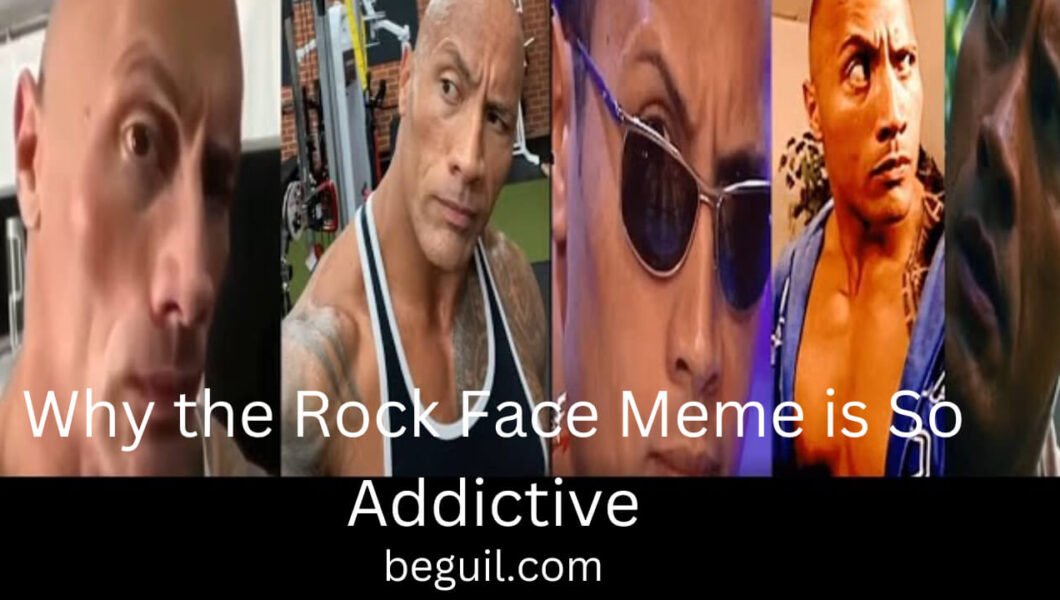1. Introduction
The internet is a breeding ground for viral trends, and in recent times, one particular meme has captured the attention and fascination of millions: the Rock Face meme. This peculiar image, featuring actor Dwayne “The Rock” Johnson sporting an exaggeratedly intense facial expression, has spread like wildfire across social media platforms, captivating users around the globe. Beyond its initial comedic value, there is something deeper at play that keeps us coming back for more. This article delves into the psychology behind why the rock meme face is so addictive, exploring the power of facial expressions, the allure of emotional ambiguity, the role of relatability, the science of dopamine, the impact of humor, the significance of social validation, and how this meme reflects changing cultural norms. By unraveling the hidden mechanisms behind this addictive phenomenon, we aim to shed light on the fascinating world of internet meme culture and its profound psychological effects.
2. The Power of Facial Expressions: Understanding the Psychology
2.1 The Importance of Facial Expressions in Communication
Facial expressions have been a crucial aspect of nonverbal communication since the dawn of humanity. From joy to anger, sadness to surprise, our faces serve as powerful conduits for conveying emotions and connecting with others. Our ability to read facial expressions accurately is deeply rooted in our evolutionary history, as it allows us to understand the intentions and feelings of those around us.
2.2 Facial Expressions and Emotional Perception
Research has shown that facial expressions play a vital role in how we perceive and process emotions. Seeing a particular expression can trigger a cascade of reactions in our brains, leading to empathy, contagion of emotions, and even alterations in our own mood. The Rock Face Meme capitalizes on this psychological phenomenon, as his powerful grimace sparks a range of emotional responses in viewers, from amusement to curiosity, and even a sense of shared intensity.
3. The Appeal of Emotional Ambiguity in Memes
3.1 The Allure of Mixed Emotions
One intriguing aspect of the rock meme face is its ability to evoke a mix of emotions simultaneously. The image captures a moment between laughter and seriousness, joy and intensity, leaving viewers in a state of emotional ambiguity. This contrast creates a sense of novelty and unexpectedness, which can be incredibly appealing in the world of memes where users constantly search for fresh and engaging content.
3.2 The Impact of Ambiguity on Engagement
Ambiguity, when used skillfully, can be a powerful tool for engagement. The Rock Face, with its blend of conflicting emotions, keeps viewers intrigued and coming back for more. It invites us to interpret the meme in our own unique ways, sparking discussions, debates, and the sharing of hilarious captions or relatable anecdotes. In a digital landscape where attention spans are short, the Rock Face Meme’s emotional ambiguity keeps us hooked and fuels its viral success.
4. The Role of Relatability: Identifying with the Rock Face Meme
4.1 The Human Desire for Connection and Relatability
Humans are social creatures wired for connection. We constantly seek opportunities to relate to others and find common ground. The Rock Meme taps into this innate desire for relatability, as many viewers can recognize and empathize with the intense and exaggerated expressions depicted in the image. It’s almost as if The Rock’s face captures the relatable moments of intensity that we all experience at some point in our lives.
4.2 Finding Ourselves in the Rock Face Meme
By finding ourselves in Rock Meme, we create a sense of camaraderie with others who share our experiences. Whether it’s the frustration of a difficult workout, the determination to achieve a goal, or the sheer absurdity of everyday life, the meme becomes a vessel for self-expression and the validation of shared emotions. In a world that can often feel isolating, the Rock Face offers a humorous reminder that we’re not alone in our weird and wonderful human experiences. So, the next time you come acrossRock Face Meme, take a moment to appreciate the psychology behind its addictive allure. From the power of facial expressions to the appeal of emotional ambiguity and our innate desire for connection, this meme reminds us of the fascinating ways in which our minds and emotions interact in the digital realm. And hey, it’s also just plain hilarious!
5. The Science of Dopamine: How Memes Trigger Addiction
5.1 The Dopamine Reward System and its Role in Addiction
When it comes to addiction, dopamine is the superstar of the show. This neurotransmitter is responsible for rewarding our brains when we experience something pleasurable, be it a delicious meal or a funny meme. The release of dopamine creates a sense of satisfaction and motivates us to seek out more of that pleasurable experience.
5.2 Memes as Stimuli for Dopamine Release
Memes, with their bite-sized jokes and relatable content, provide the perfect stimuli for dopamine release. When we stumble upon a hilarious meme like the Rock Face, our brains light up like a Christmas tree. The unexpected punchline or relatable situation triggers a surge of dopamine, leaving us craving for more instant gratification.
6. The Role of Humor: Why the Rock Face Meme is Laugh-Out-Loud Funny
6.1 The Psychology of Humor and its Effects
Humor has a unique way of connecting people and lifting their spirits. It lightens the mood and allows us to see the world from a different perspective. Psychologists believe that laughter triggers the release of endorphins, which are our brain’s natural feel-good chemicals. So when we laugh at a meme like the Rock Face, we’re not just having a giggle, we’re also boosting our well-being.
6.2 Analyzing the Humor Elements in the Rock Face
The Rock Face meme’s humor lies in its simplicity and clever twist. It takes an everyday situation that we can all relate to, like feeling overwhelmed or caught off guard, and adds a humorous twist by superimposing Dwayne “The Rock” Johnson’s surprised expression. The combination of unexpectedness, familiarity, and the larger-than-life persona of The Rock makes it a recipe for laugh-out-loud comedy gold.
7. Social Validation and Memes: The Impact of Sharing and Receiving Reactions
7.1 The Significance of Social Validation in Online Communities
In the vast world of the internet, social validation plays a crucial role in shaping our online experiences. Sharing memes allows us to connect with others and seek validation through likes, comments, and shares. It’s that human need for acceptance and the excitement of being part of a community that drives us to share the Rock GIF Face meme with our friends.
7.2 The Role of Reactions and Comments in Memes
Rock Face meme sparks conversations and reactions like wildfire. Whether it’s a simple “LOL” or a long thread of hilarious comments, the meme becomes a catalyst for social interaction. Receiving a flood of likes and comments on our shared meme not only boosts our ego but also strengthens our sense of belonging in the vast ocean of the online world.
Conclusion
In conclusion, the Rock Face GIF Meme has undoubtedly made its mark on internet culture, captivating our attention and triggering a range of emotional responses. From the power of facial expressions to the allure of relatability and the addictive effects of dopamine, this meme has tapped into the intricate workings of our psychology. As we continue to engage with and share memes like the Rock Face, we navigate the ever-evolving landscape of online communication and cultural expression. The Rock meme serves as a reminder of the profound influence that memes and internet culture have on our lives, leaving us eagerly awaiting the next viral sensation that will capture our collective imagination.
FAQ
Q1. Why is the Rock Face meme so popular?
A.The Rock Face meme’s popularity can be attributed to several factors. Firstly, its exaggerated facial expression captures attention and elicits an immediate emotional response. Additionally, the meme’s emotional ambiguity allows for multiple interpretations, making it relatable to a wide range of individuals. Furthermore, the meme’s association with Dwayne Johnson, a well-known and beloved figure, adds to its appeal and shareability.
Q2. Why do memes like the Rock Face become addictive?
A.Memes, including the Rock Face GIF meme, can trigger addictive behavior due to their ability to release dopamine in our brains. Dopamine, a neurotransmitter associated with pleasure and reward, is released when we encounter novel and enjoyable stimuli, such as humorous or relatable memes. This release of dopamine creates a positive reinforcement loop, leading to an increased desire to seek out and engage with similar content.
Q3. How does social validation play a role in the popularity of memes?
A.Social validation, the reassurance and recognition received from others, plays a significant role in the popularity of memes. When we share a meme and receive positive reactions or comments from our peers, it reinforces our sense of belonging and acceptance. Memes, including the Rock Face meme, often evoke strong reactions and encourage engagement, leading to increased sharing and validation within online communities.
Q4. Are memes like the Rock memes reflective of changing cultural norms?
A.Yes, memes can reflect changing cultural norms. The Rock memes, like other memes, serves as a cultural artifact, capturing and commenting on societal trends, attitudes, and behaviors. As memes are created, shared, and evolve, they can reflect shifts in humor, values, and social dynamics. The popularity of the Rock Face meme indicates its resonance with current cultural sentiments, providing insight into the ever-changing landscape of online communication and cultural expression.






